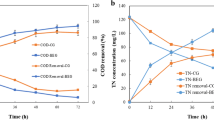Abstract
Bioaugmentation of activated sludge systems with specialised bacterial strains could be a powerful tool to improve several aspects in wastewater treatment processes, such as improved flocculation and degradation of recalcitrant compounds. This review focuses on the addition of strains to activated sludge to enhance the biodegradation of recalcitrant compounds, either through the activity of the inoculated strain or after transfer of degradative plasmids to activated sludge bacteria. Different factors that improve the aggregation of the sludge flocs and their influence on biodegradation are described. This review further deals with the role of bacterial plasmids in natural genetic exchange between inoculated and indigenous sludge bacteria, and in the construction of new genetically modified organisms. The few successful cases of bioaugmentation described in this review, together with future research, must lead to a better understanding of sludge bioaugmentation.
Similar content being viewed by others
Author information
Authors and Affiliations
Additional information
Received: 5 January 1998 / Received revision: 20 April 1998 / Accepted: 20 April 1998
Rights and permissions
About this article
Cite this article
Limbergen, H., Top, E. & Verstraete, W. Bioaugmentation in activated sludge: current features and future perspectives. Appl Microbiol Biotechnol 50, 16–23 (1998). https://doi.org/10.1007/s002530051250
Issue Date:
DOI: https://doi.org/10.1007/s002530051250




